About Lyndon LaRouche
Lyndon LaRouche (1922–2019) was America’s foremost statesman and thinker. If there is one person who embodies that revolutionary spark needed to break the chains from the bleak downward spiral of the recent decades, it is Lyndon LaRouche. He founded and led a political movement starting in the latter half of the 1960s, up until his death in 2019, making so many accomplishments it is impossible to list them all in one place. He ran for president eight times, successfully forecasted many crucial economic and political shifts, wrote hundreds of articles fundamentally advancing a number of fields, worked with and befriended dozens of world leaders, founded a political-intelligence magazine, Executive Intelligence Review, which remains today a paramount source for truthful analysis, and laid the groundwork for a completely new system of international and economic relations free from the grip of oligarchism.
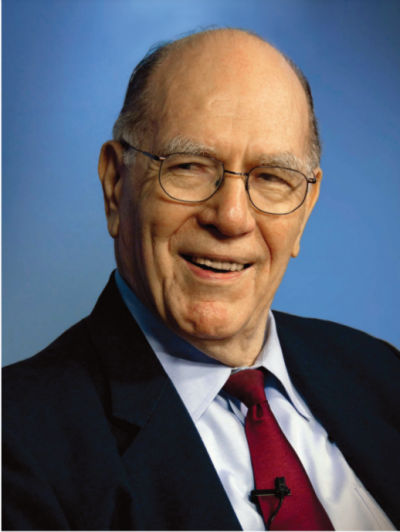
Lyndon LaRouche, 1922-2019
After serving in Burma during World War II, LaRouche spent some time in India where he was forever impacted by his experiences there. The level of brutality against the Indian people during those final days of British occupation so disturbed him, that he was determined to rid from this earth that form of inhumanity which he saw. Later in his life, LaRouche noted how this experience would shape what became his life-long commitment: “that the United States should take post-war world leadership in establishing a world order dedicated to promoting the economic development of what we today call ‘developing nations.’”
Returning home, LaRouche familiarized himself with all types of political groupings at the time so as to measure who was up to the task. After being unimpressed generally, he resolved that he would have to take up that responsibility personally. This decision was only strengthened after the string of assassinations, from John F. Kennedy, Malcolm X, Martin Luther King Jr, and Bobby Kennedy, and ensuing escalation of the disastrous war in Vietnam—the United States was losing its mission.
Then, in August 1971, Richard Nixon made the fateful decision to pull out of the Bretton Woods system. Bretton Woods had been set up by Franklin Roosevelt’s Administration to aid in the industrial development of the world by using the stability of the U.S. dollar. Though it never lived up to Roosevelt’s original intention, Nixon’s abandonment of it by “floating” the exchange rates turned the dollar, and by default the world economy, into a speculative paradise. Thus, rather than Roosevelt’s intention to prioritize industrial and infrastructure investment to build up the U.S. and the world, we instead prioritized monetary profits at the expense of industry and infrastructure worldwide. LaRouche warned at the time that this decision, if not reversed, would lead to (and was intended to achieve) austerity and looting, first in the developing sector, and then in the U.S. and Europe, eventually leading to the imposition of fascist governments to quell unruly populations—all the while trying to hold off a hyperinflationary collapse.
Being the only economist who saw this coming, LaRouche began recruiting a movement armed with the only weapon that is absolutely required to win this war: a self-reflective method of thinking. In 1975, LaRouche proposed the International Development Bank, a plan to strengthen every currency in the world through long-term, low-interest credit for development projects and capital-goods exports to the underdeveloped sector. Within a year, this plan was implicitly adopted by the Non-Aligned Movement, a group of 86 nations largely in the underdeveloped sector, with LaRouche’s friend, India’s Prime Minister Indira Gandhi, as one of their leading voices. LaRouche would go on to propose a plan for a New Bretton Woods, as well as in-depth reports for the industrial development of Africa, of Mexico, of South America, of Southwest Asia, of India and the Indian Ocean Basin, not to mention the United States and others. LaRouche knew that if credit was taken away from financial profiteering and instead vectored towards productive activity, this would not only be the basis for solving every problem in the world—from geopolitical conflicts to poverty and backwardness—but also that mankind would naturally mature culturally as science and technological mastery become more and more widespread.
This process grew, as did LaRouche’s movement. Key leaders from the Civil Rights Movement joined him, as did leading scientists, academics, political leaders, and others from around the world. Part of the degradation of our political and economic system has been due to the increasingly depraved popular culture and educational system, which is why LaRouche insisted on reviving true Classical culture and creating a New Renaissance. Leading artists, musicians, and actors, such as Norbert Brainin of the famous Amadeus Quartet and singer Piero Cappuccilli, joined with LaRouche to insist that art and culture must serve to ennoble mankind rather than to merely excite his senses, as a necessary step to educate and “tune” our citizens.
By the mid 1980s, LaRouche had seriously shocked the political establishment. He had thousands of candidates running for every level of public office, was publishing the second largest subscription science magazine, Fusion, and had many world leaders working personally with him to push for a new international financial system based on physical economic development. These included notably India’s Indira Gandhi and Mexico’s President José López Portillo. LaRouche served as a back-channel negotiator to the Soviet Union for the Reagan Administration, in a position of influence that set the stage for Reagan’s 1983 offer to the Soviet Union of a policy based on LaRouche’s proposal, the Strategic Defense Initiative—over the howls of most of his cabinet and the political establishment. The SDI announcement, although never accepted by the Soviets, would have fundamentally eliminated the threat of thermonuclear war by jointly developing defensive systems with the Soviets. If passed, it would have provided an exit from the geopolitical wet dreams of the British Empire.
LaRouche’s enemies never forgave him for this. A 400-agent federal raid was conducted on LaRouche’s house and political offices in 1986, in an attempt to kill LaRouche in the process. His publications were bankrupted and political operations ordered to cease. Robert Mueller (sound familiar?), one of the lead attorneys in the case against LaRouche, had to abandon the initial case in Boston when it began to fall apart; a new case was quickly moved through trial in Alexandria, Virginia, where the whole process could be made much more “friendly.” LaRouche was railroaded into prison on fraudulent charges, where he would spend 5 years, and brown-nosing journalists were brought out to slander him with every nonsensical attack imaginable. Similarly, financial warfare was declared on Mexico, creating massive capital flight and neutralizing López Portillo, followed by Indira Gandhi’s assassination in 1984.
Not only did LaRouche continue fighting from prison, but he even ran for president in 1992 while incarcerated. When the Berlin Wall fell and the Soviet Union collapsed, LaRouche and his wife, Helga Zepp-LaRouche, proposed taking the “productive triangle” of Paris-Berlin-Vienna, at the time the most concentrated area of machine-tool and productive capability in the world, as a model for the development of the former Soviet economies of Eastern Europe. This proposal grew into the “Eurasian Land-Bridge” and “New Silk Road,” and later the “World Land-Bridge.” The central idea was that of “development corridors” consisting of rail and other infrastructure stretching like arteries into every corner of the world. A project of this scale would create “enough work to put this whole planet into an economic revival,” LaRouche remarked. Helga Zepp-LaRouche took this proposal around the world, hosting conferences on every continent during the 1990s, with leaders from countless countries. One such event in Beijing, China in 1996, earned her the nickname the “Silk Road Lady,” still used to this day.
Despite this, conditions in the United States and Europe continued to deteriorate. Further financial speculation became the norm during the 1990s and early 2000s, leading into the financial crisis of 2007–2008—another event LaRouche forecast. Rather than addressing the bankruptcy of the financial system and reorganizing it along the lines LaRouche had proposed, treasonous networks forced through trillions in bailouts to the same financial parasites who caused the crisis, further looting our nation and people. In addition, the tragic events of 9/11 became the excuse to expand more failed wars abroad and police-state tactics at home.
However, not everyone was fooled. Beginning in 2013, Chinese President Xi Jinping announced a “New Silk Road,” in response to a clearly failing neoliberal paradigm—exactly as proposed by Lyndon and Helga LaRouche during the previous 20 years. Today, over 140 countries have joined this rapidly-growing project. Not surprisingly, China and their New Silk Road/Belt and Road Initiative are being slandered and attacked, just as LaRouche was. Nonetheless, a U.S.-China-Russia-India alliance today, around a common commitment to end poverty and industrialize every nation—in stark opposition to pushing would-be-genocidal “green investments”—would be sufficient to free the planet from the flailing grip of today’s British Empire.
As much as Lyndon LaRouche’s person was and is feared by today’s neoliberal establishment, what remains even more feared are his ideas. As poet Percy Shelley said: Poets are the unacknowledged legislators of the world. The true crime against LaRouche was not his unjust imprisonment (though it is a crime that urgently must be admitted) but it was against you, the American citizen, of depriving you of access to his ideas, and of instead causing you to think that the sewer that is today’s “left-right paradigm” is somehow an acceptable choice on the menu. Instead, LaRouche’s ideas must be freed from their shackles, and his legacy unmasked as the true soul of America—before it is too late.
LaRouche’s Four Laws
In 2014, Lyndon LaRouche issued a statement demanding the U.S. government “institute four specific, cardinal measures: measures which must be fully consistent with the specific intent of the original U.S. Federal Constitution, as had been specified by U.S. Treasury Secretary Alexander Hamilton while he remained in office.” Those measures, in brief, are:
“The immediate re-enactment of the Glass-Steagall law instituted by U.S. President Franklin D. Roosevelt,”
“A return to a system of top-down, and thoroughly defined, National Banking,”
A recognition that “the purpose of the use of a Federal Credit-system, is to generate high-productivity trends in improvements of employment, with the accompanying intention, to increase the physical-economic productivity, and the standard of living,” and
The adoption of “a Fusion-Driver ‘Crash Program,’” reflecting an understanding of “the essential distinction of man from all lower forms of life.”
He concluded his statement: “A fusion economy is the presently urgent next step, and standard, for man’s gains of power within the Solar system, and, later, beyond.”
Read LaRouche’s statement at thelarouche.org/4laws

Left:
Right: LaRouche is greeted by civil rights leader Amelia Boynton Robinson at a Feb. 1994 Washington, D.C. conference, the first LaRouche attended after his parole was achieved through an international effort led by his wife, Helga Zepp-LaRouche (center).
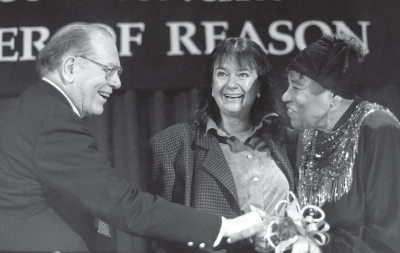
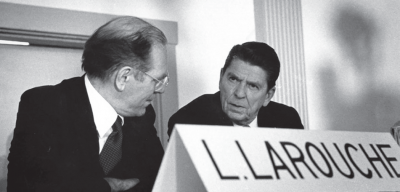
Left:
Right: LaRouche in discussion with young attendees at a Schiller Institute conference in the early 2000s.
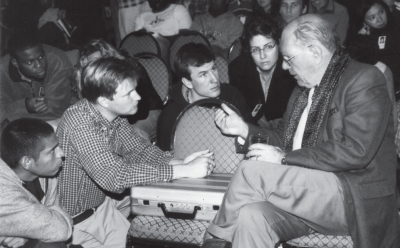
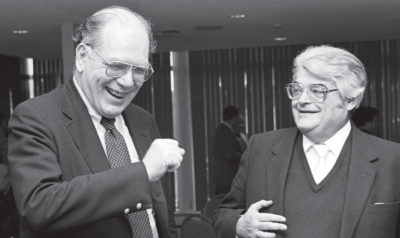
Left:
Right: LaRouche presents his typical collapse function, the “triple curve,” at a Washington, D.C., webcast event on Jan. 17, 2008.
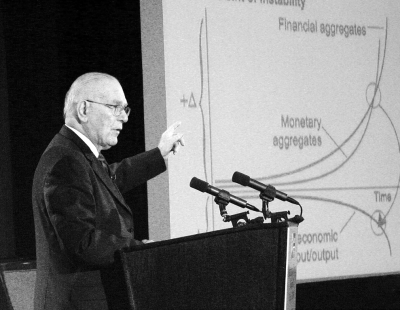
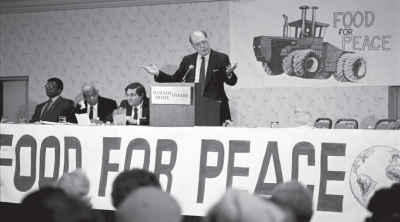
Left:





